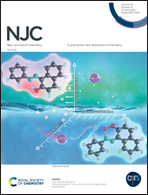High UV shielding and mechanical properties of shellac composite film for fruit packaging†
Abstract
Shellac, a naturally degradable material, was used as a carrier to load some functional and active compounds in the packaging fields. It is rarely used directly as a substrate to prepare packing films due to its unsatisfactory solubility and mechanical properties. In this research, ammonia was used as a solvent to dissolve shellac which helped form a smooth and tough shellac film via the interaction between shellac and ammonia. Moreover, a shellac composite film was formed by additional cellulose nanofibers (CNF). The properties of the shellac composite films (SAmCxPS) were regulated by modulating the concentrations of ammonia and CNF. The prepared films were characterized by a scanning electron microscope (SEM), NanoS Zetasizer, thermogravimetric analysis (TGA), and UV-Vis spectrophotometer, and their tensile strength was also determined. The results revealed that the shellac composite films were successfully prepared and were very thermally stable. The maximum tensile stress of the shellac composite films with 0.9 wt% CNF could reach 20.5 MPa. Such a high tensile stress indicated significantly improved mechanical properties. Moreover, the shellac composite films also showed good UV barrier properties, which reduced the ripeness of the fruit. Overall, the improvement in the stability and mechanical and UV barrier properties of shellac can broaden its application in the field of packaging.



 Please wait while we load your content...
Please wait while we load your content...